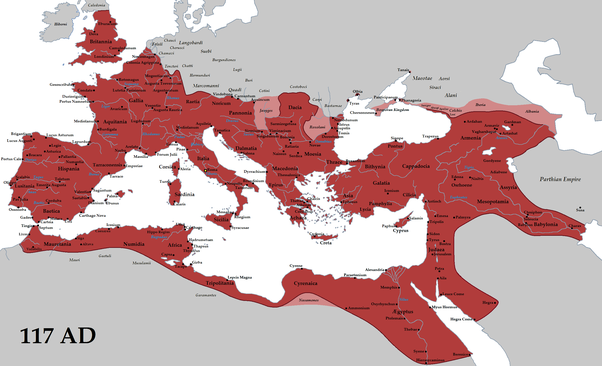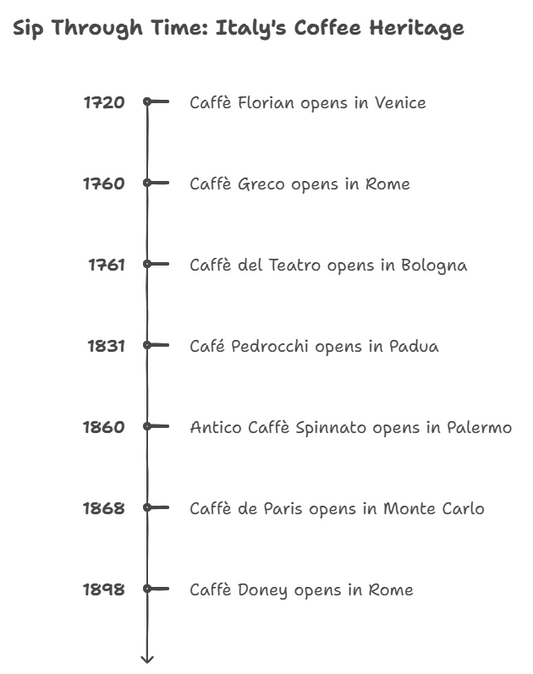Is Rome really as big as described by historians? If you compare it with the USA, it is not as big as you think.
How big was Rome at its peak? At its peak in 117 AD under Trajan, the Roman Empire was around 5 million square kilometers (around 53,819,552,083,548.61 sqft) which is around 51% the size of the USA. Rome has around 60 million inhabitants which is around 18% of the USA's 2021 population.
The highest resolution map showing the spread of Rome at its peak can be found in Wikipedia, provided by a user Tataryn. The width of the area is so big due to the large stretch of the Mediterranean Sea. It shows the Roman empire reign going
- As far south as Egypt
- As far west as Portugal
- As far north as Britain
- As far east as Turkey

Source: Wikipedia
The Latin phrase imperium sine fine ("empire without end" ) expressed the ideology that neither time nor space limited the Roman Empire.
- In Virgil's epic poem the Aeneid, the limitless empire is said to be granted to the Romans by their supreme deity Jupiter.
- This claim of universal dominion was renewed and perpetuated when the Empire came under Christian rule in the 4th century.
We also shared an article that looks into how Rome transformed itself from a small city-state to the most powerful empire ever seen. With insights into its militaristic government structure, conquests in Europe and North Africa, expansion of infrastructure and development of law codes - it dives into how Rome was able to become one of the earliest great powers in history.
Roman Empire vs US size
A Reddit user overlayed the Roman Empire with the current USA to show how big it is compared to USA. In reality, it is around half the size of the US due to the area mostly spaced out by the Mediterranean Sea.

Source: Reddit / Quora
Roman Provinces Map

Source: Quora
A color-coded map was shared in Quora by Eric Nicholson showing the different provinces. The Roman administration needs a better organization as the empire was very great and large, a huge complex of populations, tribes, traditions, and cultures with just a core: the city of Rome.
Trajan, the "Optimus Princeps" (the best ruler), divided the Roman Empire into 46 provinces, doubling the number of provinces to achieve better rule.
- The provinces in the interior of the country were run by governors chosen by the Senate, a legislative body run by leading aristocrats.
- Border provinces were run by governors named directly by the emperor. This was a security measure. Border provinces needed armies to defend against invasion, and emperors worried that if these troops were put under the control of someone not personally loyal to the emperor, that person could try to seize power and proclaim himself emperor.
At its peak, Rome stretched over much of Europe and the Middle East. The Roman Empire conquered these lands by attacking them with unmatched military strength, and it held onto them by letting them govern themselves.
Nevertheless, Rome failed to win the Roman-Persian Wars conclusively as it lasted for nearly 700 years and were fought from the 1st century BC until the 7th century AD. While there were victories on both sides, such as the Romans' victory at Resaena in 244, and the Persians' victory over Romans under Galerius in 296, neither side could conquer the other.
Rome's desire to expand had deep historical roots, says Edward J. Watts , a professor of history at the University of California, San Diego, and author of Mortal Republic: How Rome Fell Into Tyranny said to history.com:
“There's a tradition going back to basically Roman prehistory, mythological history, where they talk about the expansion of the city under the kings,.Marcius is one of the early Roman kings [ from 642 to 617 B.C .], and he's said to actually have engaged in expansion and extended the city to incorporate other hills. So the idea of them expanding is always deep in the historical DNA of the republic, and even the monarchy before the republic.”
Roman Empire Population
Did you know? During the 2nd century, the city of Rome had more than 1 million inhabitants and no Western city would have as many until the 19th century.
How populous was the Roman Empire at its peak?
The population of the Roman Empire is difficult to determine with certainty, as it varied over time and varied widely across the different regions of the empire. However, estimates for the population of the Roman Empire at its height (around 117 AD) range from a low of about 46 million (from Bruce Frier) to a high of about 80 million (Beloch).
In 1886, the prominent German academic historian, Karl Julius Beloch, began modern research with his study of the population of ancient Greco-Roman world (Die Bevölkerung der griechisch-römischen Welt). Initially, Beloch estimated the empire's population in 14 CE to be around 54 million; however, he changed this figure to 70-80 million afterwards, asserting he underestimated the total population of Gaul (modern France) and various other areas. Twentieth-century scholars broadly considered that his initial estimate was actually a bit too large. Bruce Frier's influential guess set the number during Augustus' rule at about 46 million. Recent studies are more open to envisioning a higher figure. Walter Scheidel suggested a peak amount of 59-72 million existed in 164 CE directly prior to the inception of the notorious "Antonine plague".
Wikipedia also shared the population growth of the Roman empire in comparison with the world.
- The territory of the Roman Empire saw an average annual population growth of about 0.1 percent from the 12th century BCE to the 3rd century CE, resulting in a quadrupling of the region's total population
- Growth was slower around the eastern Mediterranean, which was already more developed at the beginning of the period, on the order of about 0.07 percent per year.
- This was stronger growth than that seen in the succeeding period; from about 200 CE to 1800 CE, the European half of the empire only saw about 0.06 to 0.07 percent annual growth
- Europe as a whole saw 0.1 percent annual growth rates), and the north African and west Asian parts of the empire saw almost no growth at all.
- By comparison, what is now the territory of China experienced 0.1 percent annual growth from 1 CE to 1800 CE.
Besides that, mortality was also derived. The population was considerable, given that people tend to die earlier in the era without modern medicine. At one point, it was said that 20% of the world population was part of the Roman Empire.
- When infant mortality is factored out [i.e. counting only the 67 -75% who survived the first year], life expectancy is around 34-41 more years
- When child mortality is factored out [i.e. counting only the 55–65% who survived to age 5], life expectancy is around 40–45
- The ~50% that reached age 10 could also expect to reach ~45-50
- The 46-49% that survived to their mid-teens could, on average, expect to reach around 48–54, although of course many lived much longer or shorter lives for varied reasons
In ancient Rome, the life of a gladiator wasn’t easy; they had to train hard, follow strict rules and put their lives at risk in the arena. Here's an inside look at the day-to-day life of a gladiator in Ancient Rome—from training to battle to triumph or defeat.




